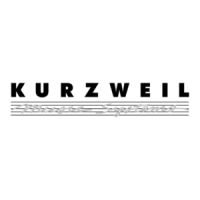4
K2600 ADAT I/O Option User’s Guide / OS 4.1 Release Notes
Software Changes in OS 4.1
Minimum
,
Medium
,
Maximum
—these utilize noise shaping in varying degrees. The noise floor has been essen-
tially equalized to make it softer at midrange frequencies, and louder at bass and treble frequencies. The overall
power level of the noise is actually higher than at the
Flat
setting, but due to the ear’s spectral response at low lev-
els, the noise floor appears lower at these settings. These values are not as useful as
Flat
for resampling, since the
boosted noise may become quite noticeable if the sample is played transposed down a couple of octaves. In addi-
tion, repeated resampling would cause buildup at the boosted frequencies.
None
—no dither. This is provided primarily for completeness. You generally never want to use this setting with 16
or 20 bit outputs, unless you are studying dither in a classroom, or you specifically want to hear digital artifacts.
Low-level signals are extremely distorted using this setting.
Digital Output Length
Change this parameter to set the digital word length of the K2600's digital output stream. Digital Output Length
values are 24, 20, and 16 bits. The default is 24 Bit, which is preferred for most applications. Reducing the bit length
will reduce the dynamic range of your sound and may increase audible noise. However, some older digital equip-
ment may not be able to work with 24 bit data, and you may have more satisfactory results by reducing the word
length at the K2600 output stage.
If you are resampling digitally, you should be sure to set Digital Output Length to 16 bits. This is because the sam-
pler is only 16 bits, and you want to make sure that the signal is properly dithered before resampling.
Digital Sample Source
This parameter only appears if you have a Sampling Option. (It also appears on the SampleMode page, where it is
called
Src.
)
Int
means internal resampling;
Ext
means use external input (external input is controlled more specifi-
cally by the Format and Cable parameter settings, if available). If the DIO-26 is installed along with the Sampling
Option, an additional value is available called
Rtn
; this selects the extra AES return that is coming in on the KDS
output connector.
Format
Change this parameter to set the K2600's AES output to your preferred format. The values are
AES Pro
, also
known as AES/EBU, and
AES Cons
, also known as S/PDIF. This global parameter is remembered across power
cycles, and is not part of any setup or KDFX studio.
Cable
This parameter only appears if a Sampling Option and a DIO-26 are installed. This parameter controls the choice
of input signal to the Sampling Option, either
Coaxial
or
Optical
. This parameter also appears on the SampleM-
ode page.
AESOut
This parameter only appears if you have a Sampling Option and a DIO-26. This controls what audio signal is sent
to the AES output on the DIO-26. Values are
Mix (A/D)
, and
A (Dir)
. This parameter used to appear on the Sample
Mode page.
When your K2600 has both the Sampling and ADAT I/O Options, the output is always direct.

